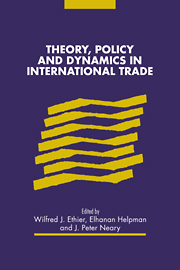Book contents
- Frontmatter
- Contents
- List of conference participants
- I Introduction
- II History, geography and the theory of trade
- III The structure of simple trade models
- IV Policy towards international trade
- 9 Welfare effects of tariffs and investment taxes
- 10 The case of the vanishing revenues: auction quotas with oligopoly
- V Trade, growth and dynamics
- Index
9 - Welfare effects of tariffs and investment taxes
Published online by Cambridge University Press: 16 March 2010
- Frontmatter
- Contents
- List of conference participants
- I Introduction
- II History, geography and the theory of trade
- III The structure of simple trade models
- IV Policy towards international trade
- 9 Welfare effects of tariffs and investment taxes
- 10 The case of the vanishing revenues: auction quotas with oligopoly
- V Trade, growth and dynamics
- Index
Summary
Introduction
In a world with internationally mobile factors of production, commercial policy is intimately bound up with the questions of whether and to what extent factor flows should be restricted. This is true even in a small open economy which cannot influence the world prices at which goods and factors are traded: non-interference with all international transactions is the first-best policy but constraints on the implementation of this policy on one category of transactions will in general imply non-zero levels of optimal second-best regulation of the other category. In a large economy which can influence its terms of goods and factor trade, the interdependence between restrictions on trade and international factor flows is even more pronounced. The first-best policy package may now call for a subsidy to some transactions rather than a tax; and constraints on policy choice may have surprising implications for the optimal values of those instruments whose values may be altered.
All these issues have been extensively considered in the literature and especially in the writings of Ronald Jones. However, the general principles underlying optimal policy choice when both goods and factors are internationally mobile seem to defy convenient synthesis. A major reason for this must be the concentration in much of the literature on the Heckscher–Ohlin case. As is well known, this framework introduces an indeterminacy in the pattern of specialization and the results obtained appear to be very sensitive to detailed assumptions about the structure of production. Two exceptions to the general concentration on the Heckscher–Ohlin case may be mentioned.
- Type
- Chapter
- Information
- Theory, Policy and Dynamics in International Trade , pp. 131 - 156Publisher: Cambridge University PressPrint publication year: 1993
- 18
- Cited by

